
Techniques and Principles in language teaching
.pdf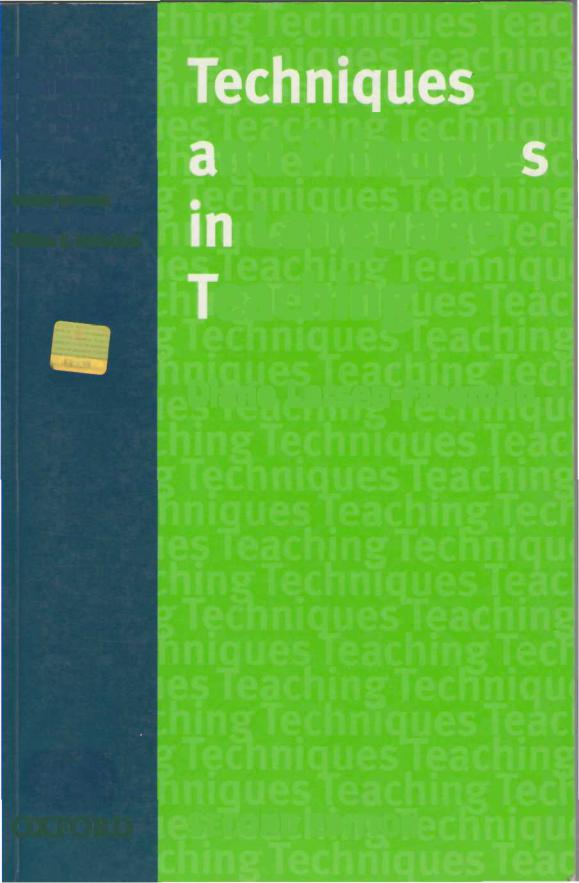
TEACHING TECHNIQUES IN ENGLISH AS A SECOND LANGUAGE
SERIES EDITORS
Russell N. Campbell
William E. Rutherford
nd Principle Language
eaching
Diane Larsen-Freeman
OXPORD SECOND EDITION
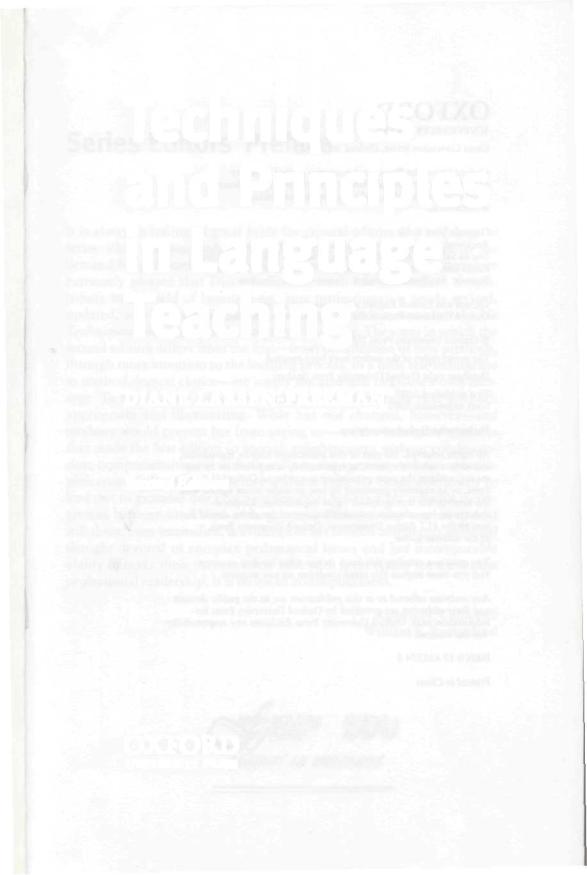
Techniques
and Principles
in Language
Teaching
DIANE LARSEN-FREEMAN
Second Edition
OXFORD
UNIVERSITY PRESS
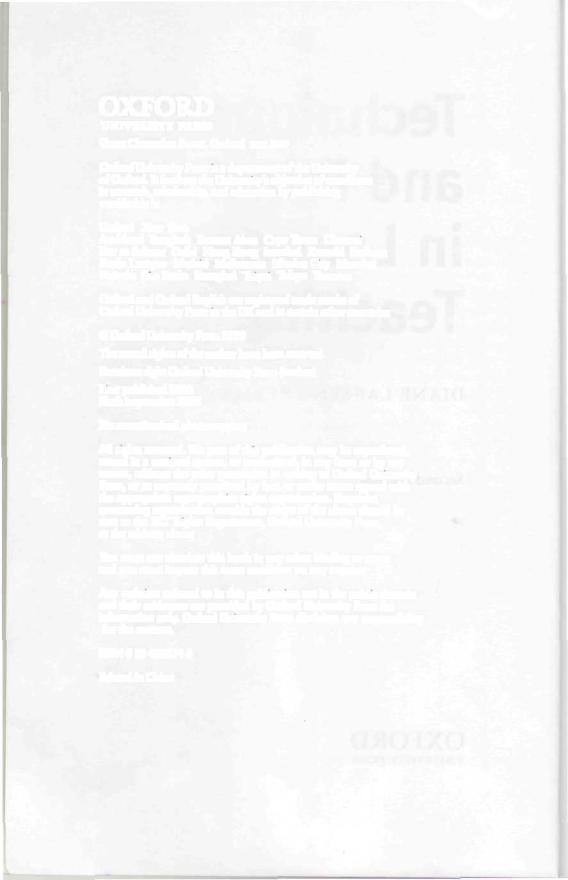
OXPORD
UNIVERSITY PRESS
Great Clarendon Strecr, Oxford oxi 6DP
Oxford University Press is a department of the University ofOxford.lt furthers the University's objective of excellence in research, scholarship, and education by publishing worldwide in
Oxford New York
Auckland Bangkok Buenos Aires Cape Town Chennai
Dar es Salaam Delhi Hong Kong Istanbul Karachi Kolkata Kuala Lumpur Madrid Melbourne Mexico City Mumbai Nairobi Sao Paulo Shanghai Taipei Tokyo Toronto
Oxford and Oxford English are registered ttade marks of Oxford University Press in the UK and in certain other countries
© Oxford University Press 2000
The moral rights of the author have been asserted
Database right Oxford University Press (maker)
First published 2000
Sixth impression 2003
No unauthorized photocopying
All rights reserved. No pan of this publication may be reproduced, stored in a retrieval system, or transmitted, in any form or by any means, without the prior permission in writing of Oxford University Press, or as expressly permitted by law, or under terms agreed with the appropriate reprographics rights organization. Enquiries concerning reproduction outside the scope of the above should be sent to the F.LT Rights Department, Oxford University Press,
at the address above
You must not circulate this book in any other binding or covet and you must impose this same condition on any acquirer
Any websites referred to in this publication are in the public domain and their addresses are provided by Oxford University Press for information only. Oxford University Press disclaims any responsibility for the content.
ISBNO 194355748
Printed in China

Series Editors' Preface
It is always a feeling of great pride for general editors of a pedagogical series when the resounding success of one of its books leads to the demand for publication of a second, expanded edition. We are therefore extremely pleased that Diane Larsen-Freeman has undertaken to contribute to the field of language-teaching professionals a newly revised, updated, and enlarged version of her original and immensely valuable
Techniques and Principles in Language Teaching. The ways in which the second edition differs from the first—from the addition of new methods, through more attention to the learning process, to a little self-indulgence in methodological choice—are amply documented in Diane's own message 'To the Teacher Educator', and these are departures that are both appropriate and illuminating. What has not changed, however—and modesty would prevent her from saying so—are the intangible qualities that made the first edition so special: enlightenment without condescension, comprehensiveness without tedium, engagement without oversimplification. Still evident as before is Diane's gift for being able gently to lead one to examine one's own professional behavior for possible incongruities between one's view of language and the way one teaches it. And still there, even intensified, is evidence of her serious and deeply personal thought devoted to complex pedagogical issues and her incomparable ability to make these matters come alive with great clarity for the widest professional readership. It is no mean accomplishment.
Russell N.Campbell
William E.Rutherford
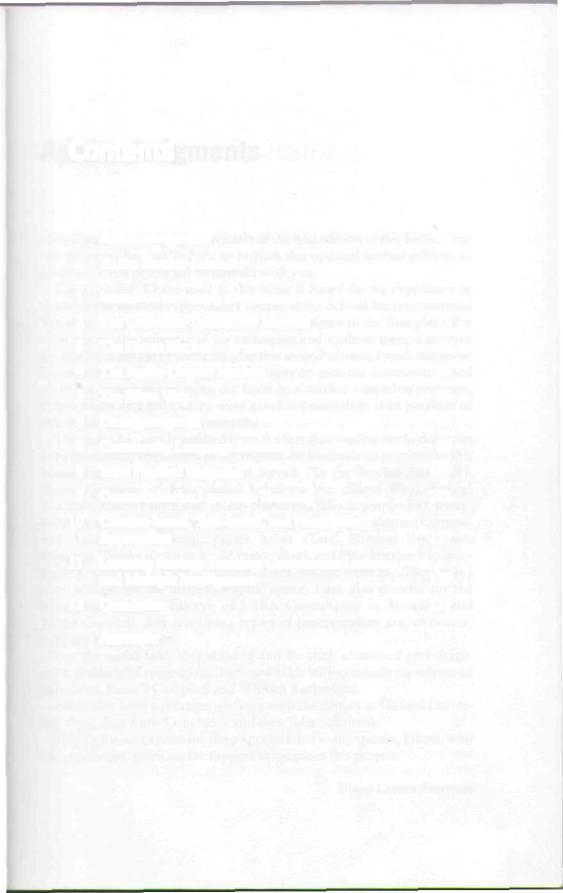
Contents
|
Acknowledgments |
vii |
|
To the Teacher Educator |
ix |
1 |
Introduction |
1 |
2 |
The Grammar-Translation Method |
11 |
3 |
The Direct Method |
23 |
4 |
The Audio-Lingual Method |
35 |
5 |
The Silent Way |
53 |
6 |
Desuggestopedia |
73 |
7 |
Community Language Learning |
S9 |
8 |
Total Physical Response |
107 |
9 |
Communicative Language Teaching |
121 |
10 |
Content-based, Task-based, and Participatory |
|
|
Approaches |
137 |
11 |
Learning Strategy Training, Cooperative Learning, |
|
|
and Multiple Intelligences |
159 |
12 |
Conclusion |
177 |
|
Appendix |
191 |
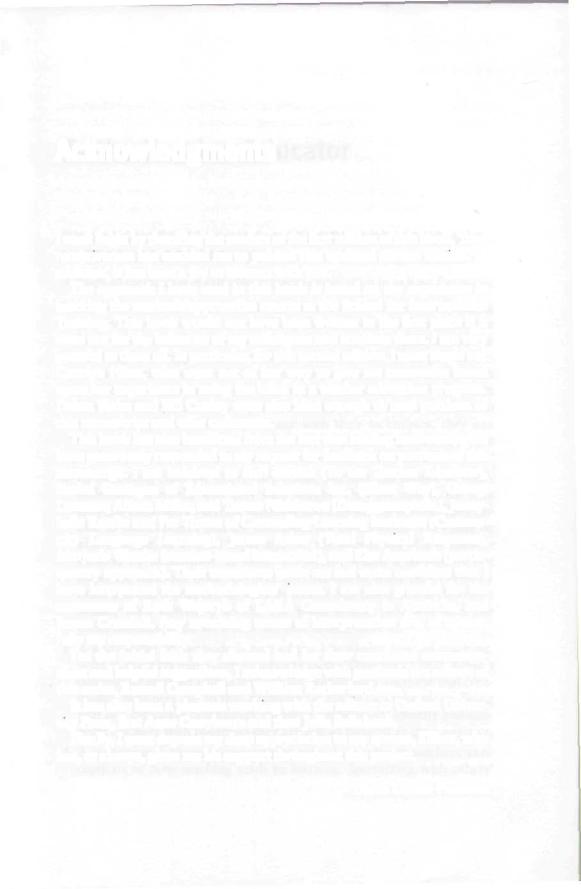
Acknowledgments
I must begin by thanking the readers of the first edition of this book. Your receptiveness has enabled me to publish this updated second edition. In addition, it has been a joy to interact with you.
The approach I have used in this book is based on my experience in teaching the methods/approaches course at the School for International Training. This book would not have been written in the first place if it were not for the influence of my colleagues and students there. I am very grateful to them all. In particular, for this second edition, I must single out Carolyn Nims, who went out of her way to give me comments based upon her experience in using the book in a teacher education program. Debra Blake and Bill Conley were also kind enough to read portions of this manuscript and offer comments.
This book has also benefitted from the fact that leading methodologists have generously responded to my request for feedback on portions of this manuscript. I am indebted to Earl Stevick (To the Teacher Educator), Shakti Gattegno of Educational Solutions Inc. (Silent Way), Georgi Lozanov, Alison Miller, and Tetsuo Nishizawa (DesuggestopediaI, Jennybelle Rardin and Pat Tirone of Counseling-Learning Institutes (Community Language Learning), James Asher (Total Physical Response), Marjorie Wesche (content-based instruction), and Elsa Auerbach (participatory approach). Their comments made me feel more confident that I have interpreted the methodologists' intent. I am also grateful for the comments of Ruth Wajnryb of LARA Consultancy in Australia, and Joann Crandall. Any remaining errors of interpretation are, of course, fully my responsibility.
For the initial faith they showed and for their continued encouragement and helpful suggestions, I acknowledge with gratitude the editors of this series, Russell Campbell and William Rurherford.
It has also been a pleasure working with the editors at Oxford University Press, first Anne Conybeare and then Julia Sallabank.
Finally, I must express my deep appreciation to my spouse, Elliott, who has, as always, given me his support throughout this project.
Diane Larsen-Freeman
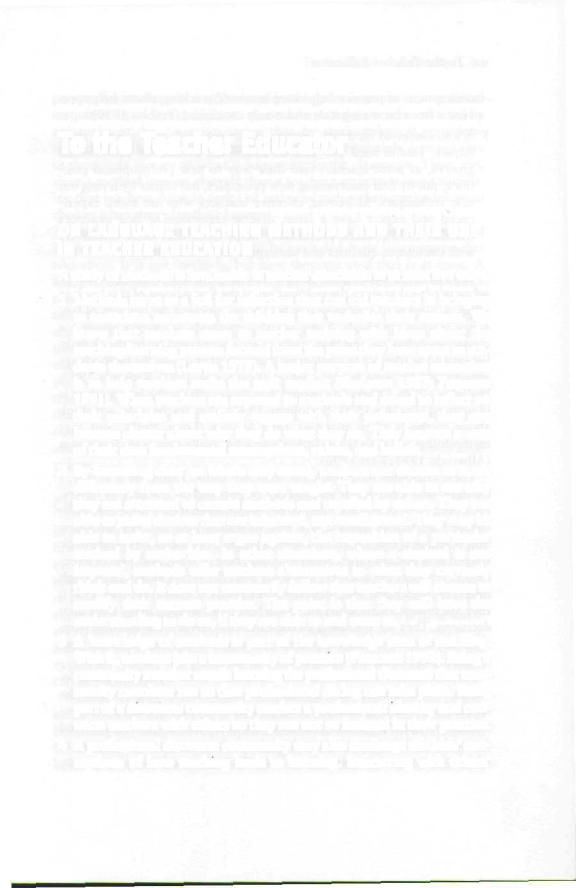
To the Teacher Educator
ON LANGUAGE TEACHING METHODS AND THEIR USE IN TEACHER EDUCATION
A study of methods is invaluable in teacher education in at least five ways:
1 Methods serve as a foil for reflection that can aid teachers in bringing to conscious awareness the thinking that underlies their actions. We know that teachers come to teacher training with ideas about the reaching/learning process formed from the years they have spent as students themselves {Lortie 1975). A major purpose of teacher education is to help teachers make the tacit explicit (Shulman 1987; Freeman 199 1). When teachers are exposed to methods and asked to reflect on their principles and actively engage with their techniques, they can become clearer about why they do what they do. They become aware of their own fundamental assumptions, values, and beliefs.
2By becoming clear on where they stand, teachers can choose to teach differently from the way they were taught. They are able to see why they are attracted to certain methods and repelled by others. They are able to make choices that are informed, not conditioned. They may be able to resist, or at least argue against, the imposition of a particular method by authorities. In other situations, where a method is not imposed, methods offer teachers alternatives to what they currently think and do. It does not necessarily follow that teachers will choose to modify their current practice. The point is that they will have the understanding to do so, if they are able to and want to.
3A knowledge of methods is part of the knowledge base of teaching. With it, teachers join a community of practice (Freeman 1992). Being a community member entails learning the professional discourse that community members use so that professional dialog can take place. Being part of a discourse community confers a professional identity and connects teachers with others so they are not so isolated in their practice.
4A professional discourse community may also challenge teachers' conceptions of how teaching leads to learning. Interacting with others'
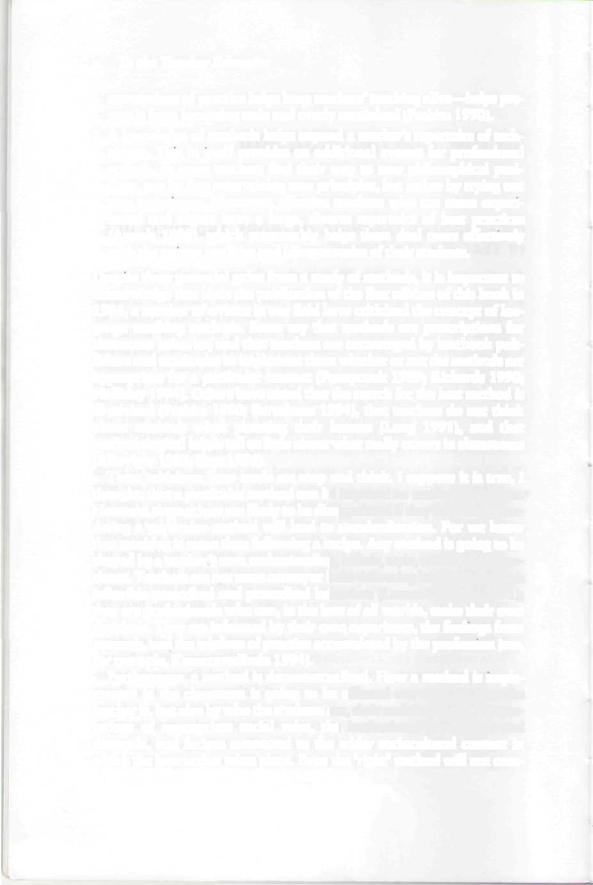
x To the Teacher Educator
conceptions of practice helps keep reachers' teaching alive—helps prevent it from becoming stale and overly routinized (Prabhu 1990).
5A knowledge of methods helps expand a teacher's repertoire of techniques. This in itself provides an additional avenue for professional growth, as some teachers find their way to new philosophical positions, not by first entertaining new principles, but rather by trying out new techniques. Moreover, effective teachers who are more experienced and expert have a large, diverse repertoire of best practices (Arends 1998), which presumably helps them deal more effectively with the unique qualities and idiosyncrasies of their students.
Despite these potential gains from a study of methods, it is important to acknowledge that since the publication of the first edition of this book in 1986, a number of writers in our field have criticized the concept of language teaching methods. Some say that methods are prescriptions for classroom behavior, and thar teachers are encouraged by textbook publishers and academics to implement them whether or nor the methods are appropriate for a particular conrext (Pennycook 1989; Richards 1990; Holliday 1994). Others have noted thar the search for the best method is ill-advised (Prabhu 1990; Bartolome 1994), that teachers do not think about methods when planning their lessons (Long 1991), and that methodological labels tell us little about what really occurs in classrooms (Allwright 1988; Karz 1996).
These criticisms have made me srop and rhink. I suppose it is true, I thought, that a particular method can be imposed on teachers by others. However, these others are likely to be disappointed if they hope that mandating a particular method will lead to standardizarion. For we know that teaching is more than following a recipe. Any method is going to be shaped by a teacher's own understanding, beliefs, style, and level of experience. Teachers are not mere conveyor belts delivering language through inflexible prescribed and proscribed behaviors (Larsen-Freeman 1991); they are professionals who can, in the best of all worlds, make their own decisions. They are informed by their own experience, the findings from research, and the wisdom of practice accumulated by the profession (see, for example, Kumaravadivelu 1994).
Furthermore, a method is deconrextualized. How a method is implemented in the classroom is going to be affected not only by who the teacher is, but also by who the students are, their and the teacher's expectations of appropriate social roles, the institutional constraints and demands, and factors connected to the wider sociocultural context in which rhe insrrnction takes place. Even the 'right' method will not com-
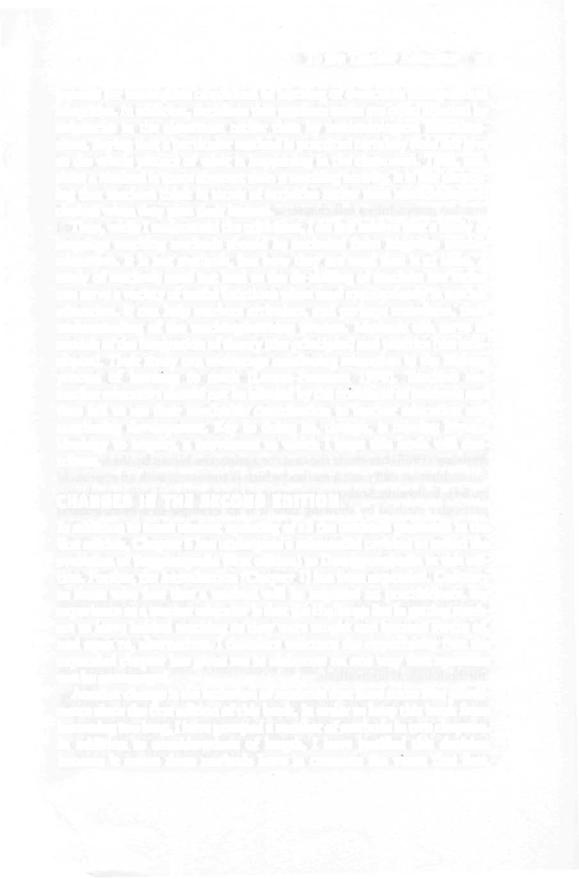
To the Teacher Educator xi
pensatc for inadequate conditions of learning or overcome sociopolitical inequities. In addition, decisions that teachers make are often affected by exigencies in the classroom rather than by methodological considerations. Saying that a particular method is practiced certainly does not give us the whole picture of what is happening in the classroom. Then, too, since a method is more abstract than a teaching activity, it is not surprising that teachers think in terms of activities rather than methodological choices when they plan their lessons.
Thus, while I understand the ctiticisms, I do not believe that a study of language teaching methods should be excluded from language teacher education. It is not methods, but how they are used that is at issue. A study of methods need not lead to the de-skilling of teachers but rather can serve a variety of useful functions when used appropriately in teacher education. It can help teachers articulate, and perhaps transform, their understanding of the teaching/learning process. Methods can serve as models of the integration of theory (the principles) and practice (the techniques). Their study can encourage continuing education in the lifelong process of learning to teach (Larsen-Freeman 1998). Teachers and teacher educators should not be blinded by the criticisms of methods and thus fail to see their invaluable contribution to teacher education and continuing development. Key to doing so, though, is moving beyond ideology to inquiry, a movement to which I hope this book will contribute.
CHANGES IN THE SECOND EDITION
In addition to some modest updating of all the methods presented in the first edition, Chapter 6 has undergone a substantial revision to reflect the evolution of Suggestopedia (first edition) to Desuggestopedia in this edition. Further, the Introduction (Chapter 1) has been expanded. Contrary to those who fear that a method will be imposed on practitioners, my experience as a teacher educator is that the challenge lies in getting reachers to leave behind teaching as they were taught and become aware of, and open to, alternatives. I therefore welcome the opportunity that the expanded chapter has given me to elaborate on one way that openness can be encouraged.
Another change is the inclusion of methods that have come into prominence since the first edition of this book. In order to keep this book from becoming too long, I have grouped a number of methods in two chapters. In addition to considerations of length, I have justified this decision because it seems these methods have in common the views that first,

xii To the Teacher Educator
language can best be learned when it is taught through communication, rather than for it (Chapter 10, on content-based, task-based, and participatory approaches], and second, that language acquisition can be enhanced by working not only on language, but also on the process of learning (Chapter 11, on learning strategies, cooperative learning, and multiple intelligences).
A further substantial modification is that the epilogue of the first edition has grown into a full chapter of its own (Chapter 12) in this second edition. Readers of the first edition have told me that they wished that I had concluded with a more explicit evaluation and comparison of the methods. I chose not to do so in the first edition of this book, as I am not of the opinion that the purpose of learning about methods is so one can adopt the right one, or that I could choose for others which one that would be. However, in this second edition, I have responded to readers' requests by providing a summary chart of the methods discussed in this book, and by so doing, highlighting their major differences. 1 have also used the opportunity that a full final chapter presents to indulge myself in sharing with readers my views on making informed methodological choices.
A word about nomenclature is also in order. I am using the term 'method1 here not to mean a formulaic prescription, but rather a coherent set of links between principles and certain techniques and procedures. Anthony (1963) has made the case for a tripartite hierarchy. As he put it: 1 ... techniques carry out a method which is consistent with an approach1 (p. 64). Following Anthony, in certain of the chapters, I will inttoduce a particular method by showing how it is an example of a more general approach to language teaching. However, not all methods discussed in this book conveniently follow from a general approach. They all do, though, have both a conceptual and an operational component, fitting the definition in Richards etai. (1992): Dictionary of Language Teaching
& Applied Linguistics (a method is 'a way of teaching a language which is based on systematic principles and procedures1), and justifying my use of the term. Admittedly, I sometimes have found it difficult to use the term 'method' with more recent innovations, such as content-based instruction and coopetative learning. At times, I have resorted to the term 'methodological innovations.'
Even so, some language educators might object to the inclusion of con- tent-based, task-based, and participatory approaches in a methods book, for they might be more comfortable calling these syllabus types. Nevertheless, others feel that a method designation is very appropriate. Snow (1991), for instance, characterizes content-based instruction as a 'method
